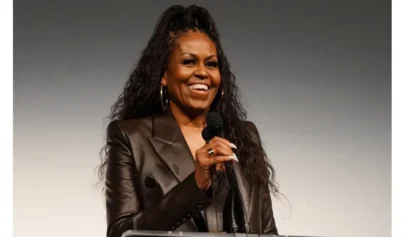An Iranian news agency altered/photoshopped the image of Michelle Obama as she presented the Best Picture award to “Argo” at the Oscars to make the First Lady appeared to be more covered up than she really was.
Many people know that women in Iran have to follow very strict guidelines when it comes to the way they dress, but when it comes to the media even foreigners aren’t allowed to show too much skin if they want their image to be seen in Iran.
While some actresses and other celebs are given a little more leeway with the dress code, Michelle Obama was no exception to the rule.
The FLOTUS looked stunning on the live telecast where she flaunted her toned arms in a flittering silver gown, but Fars (a “semi-official” Iranian agency) wasn’t happy with so much skin being exposed – can you imagine what they would have had to do with Brandi Glanville’s Oscars image? Geez.
Anyway, Fars utilized their amazing photoshopping skills to create sleeves and a high neckline on the dress to give Michelle Obama a more conservative look.
While this has some people shocked, deputy State Department spokesperson Patrick Ventrell was anything but surprised.
“We’ve persistently seen Iranian news agencies, whether they’re partially or fully state-run, use fabrication and use other means to distort images,” Ventrell said. “It’s something that we’ve see in the past here in this department.”
Back in 2011 the Iranian press also photoshopped a short sleeve t-shirt under several outfits that supermodel Gisele Bundchen wore in a H&M campaign, but don’t think they only spend time covering up women.
Several magazines in Iran have been known to edit people (particularly political figures) completely out of a photo or to block out certain people in political cartoons.
The only thing that the Iranian press found more offensive than Michelle Obama’s shoulders and arms being on full display at the Oscars this year was the very film she awarded the Oscar for Best Picture to.
Many people in Iran found the film to relay “anti-Iranian” messages and sentiments. They believed that the film created a negative stereotype of Iranians and didn’t provide a clear divide between ordinary citizens and the revolutionaries involved in the crisis
For now, however, it seems the people’s main priority is to put a halt to the government’s censorship. Protests have been breaking out urging the Iranian government to stop allowing for so much censorship in the media.
They will definitely have their hands full if they have any hopes of keeping images like the ones seen above censored for much longer.


